![]()
![]()
![]()
Use LEFT and RIGHT arrow keys to navigate between flashcards;
Use UP and DOWN arrow keys to flip the card;
H to show hint;
A reads text to speech;
24 Cards in this Set
- Front
- Back
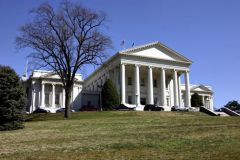
|
Thomas Jefferson, Virginia state-house, Richmond, 1785-1789
based on Maison Carree with the help of Clerisseau, made from brick and covered in stucco, established preference for neoclassicism in government buildings, gentlemen architect tradition, first to introduce neoclassical architecture, changed the order from Corinthian to ionic, reduced the depth of the portico from 3 to 2 columns and replaced the pilasters of the side walls with windows, first volley announcing the arrival of neo-classicism, symbolized democratic, republican, and humanistic values for which there new county stood |
|
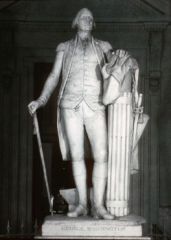
|
Jean- Antoine Houdon, George Washington, 1785-1791, executed in France and shipped to the capital in Richmond, general modern uniform and classical pose, fasces, plow allude to Cincinnatus, roman farmer and general, displayed in the rotunda of the capital building, Houdon took the bodily measurements of Washington, virtues of a humble leader are stressed, oddly proportioned, blending of rococo and new neoclassicism, hand rest on a walking stick not a sword and the other rests on the fasces a well-known greek form which the sword rests on, under the waist coat a badge of the society of the Cincinnati
|
|

|
James Hoban, Executive Mansion, Washington 1792, irish born architect, design based on Gibbs- Dublin's Leinster House, Georgian appearance w/o obvious "parisian" elements
|
|
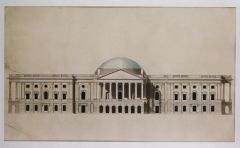
|
William Thornton, U.S. capitol, Washington, D.C., 1792, U.S. capital competition winning design, Thornton was a physician from Virgin Islands, design adapted from Roman Pantheon, Wings symbolize balance of legislative power, equal but relative to there functions, had 2 wings that would house the senate and the house with a central section fronted by a pedimented portico which led to a rotunda capped by a lower saucer dome, the design looked backwards rather then forward to the new style dominated by neo-classicism. central sections bears a general resemblance similarity to the pantheon in Rome, the wings are purely eighteen the century
|
|
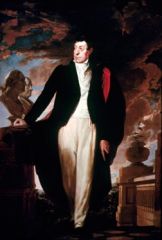
|
Samuel F.B. Morse, Marquis de Lafayette, 1825, Morse was a pupil of Allstons but also studied with West, portrait of french hero made on U.S. tour,Bold colors and brush work: informal pose, dramatic sky, bust of Washington and Franklin at left, Morse is more known fro his inventions could not find patronage for his talents, meant to flatter- presented as tall elongate and dashing, grand manner, Venetian in its coloration, used glazing to achieve dazzling effects of light, shadow and color, sunflower symbolizes unwavering devotion
|
|

|
Horatio Greenough, George Washington, 1840, Boston artists who lived worked and carved in Florence, was for the U.S. capital, Head based on Houdon statue, body on lost Zeus statue, disastrous reception, recast Washington in a god like way, there is a limit to the way Americans will perceive there leaders, moved to outside, then inside, From a prominent Boston family, Washington is portrayed bare to the waist wearing Greek garb and sandals sitting in a Greek chair giving up a greek sword with his left hand and pointed heavenward with his right
|
|
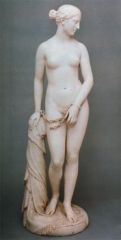
|
Hiram Powers, Greek slave, 1847, Cincinnati artist who studied lived worked and carved in Florence, Full-length figure based on Medici venus, nude justified by lofty subject, idealized form, caused public sensation; copies made, an allegory of Greek independence, looks reasonably accurate, time-less, supported with a draped shawl, Vermont- born mechanic and gadgeteer, young greek maiden who has been captured by the turks and put on the slave block. shes is stripped of all her clothes and forced to endure the stairs of men. Her wrists are chained she modestly looks away , she is christian indicated by the cross on the post
|
|

|
Edmonia Lewis, Forever Free, 1867, Female sculptor of mixed Native- African ancestry who lived and worked in Rome, sculpted images drawn from contemporary events, literature, and the bible, many rooted in her outsider status. Heartfelt, triumphal image of man and women breaking the bonds of slavery, tension between past-future, anger- gratitude, idealized heads, bodies, seemingly non-ethnic features. a member of the flock,
|
|

|
James Renwick, St. Patrick's Cathedral, N.Y. 1858-1879, designed by NY architect who traveled to France to study Gothic architecture, cruciform design 330ft high, 385 ft long, 175 ft wide, 112 ft ceiling, design scaled back and sham vaulting installed, completely built out of white marble,based on cathedrals in Reims,
the original design would have had a naive, transept crossing, side aisles, chapels, and twin towers the actual design had no radiating chapels, and no buttress, because of plasters no need for buttresses, an illusion of the apse, small ambulatory, full rose windows, breaks up into 16 part division leading up to the webbing of the vaults, star shape pattern |
|
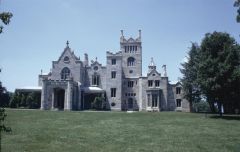
|
A.J. Davis, Lyndhurst, Tarrytown, 1838, 1864-1865, castellated design on scale of english manor, built in 2 stages for 2 successive clients- William Paulding, George Merritt, Picturesque sitting in landscaped garden, lavish interiors, miniature castle or estate, same architect brought back by 2 different owners, laid out in the picturesque manner, trees paths, free and wild elements, completely wrapped environment, fully articulated transitional space, thinness of these supporters suggest iron, clusters chimney, limestone exterior, colors are staggered, variety of window openings, plaster vaulting, walls painted to look like stone, modest Gothic villa,
|
|

|
Thomas Doughty, Fanciful Landscape, 1834, artist from Philly, imaginary view, Claude like frame with view into water and mountains, romantic wanderers, medieval ruins, popular in 1820's-30's, updated version of Paul Lorene, not meant to be north America, no people, was the first to create romantic visions of landscape scenery,
|
|

|
Thomas Cole, The Oxbow, 1836, English born artist, Ohio raised, mostly self-taught, Traveled to England, France, Italy settled in Hudson river valley, painted actual and imagined views, historical subjects, most important of the landscape painters, angry sky, dark and light, meteorological phenomenon, sublime and picturesque, tree branches, skill at conveying the vastness of the u.s., Hebrew writing on the mountains, view of Mt. Holtoke overlooking a bend in Ct. River in summer, storm vs clearing, mt vs valley, wilderness vs civilization, sublime vs picturesque, artist vs romantic spectator
|
|

|
Thomas Cole, Consummation of the Empire, 1832-1836, filled with terraced harbor, temples, treasures, monuments, wealth, commerce, dying federalist generation, ambitious 5 part series on the rise and decline of civilization, drew on knowledge of European architecture, landscapes of Claude, allegory of U.S. in throes of urbanization, the rock is the one constant element,
|
|

|
John Vanderlyn, Ariadne Alseep on the island of Naxos, 1814, studied with Stuart and went to Italy and France, rival to Trumbull's, myth of Theseus leaving Ariadne, painted in France using nude model, similar to Titian, nice skin coloring, proportions, the body all is correct, she appears part of the setting, created a small pavilion for showing,
|
|

|
John James Audubon, Wild Turkey, 1822, Caribbean artist who studied in France, made water colors across U.S. engraved and published in London, was an illustrator, like Peale tried to combine art and science, works collected in a multi-volume book, detailed illustration with identifying characteristics and marks that prove useful, proportions the bird for maximum detail, this is set in the eastern wood lands, bird nestled among grasses and bamboo, the neck is turned in a way so the opposite side can be seen, born in Haiti and raised in France, moved to Kentucky where he was a shopkeeper and then mill operator
|
|

|
William Strickland, 2nd Bank of U.S. Philadelphia, 1818-1824, former apprentice to Latrobe, developed into skilled architect and engineer, active in Philadelphia, Nashville, inventive in use of Greek-revival motifs, selected by president Biddle who had traveled to Greece, adaptation in marble of the Parthenon, some roman elements, Biddle had a lot of money, power he was well traveled and knowledgeable about Greek architecture, Looks like it has no windows, columns do not go all the way around, steps don't go all the way around, without artificial light the windows need to be unshielded, pediments are empty, pediment is the roof line, marble bad choice, functional requires more then 2 rooms, barrel vault ionic columns
|
|

|
Thomas U. Walter, Girard College, Philadelphia, 1833-1847, Philadelphia architect who studied with Strickland, embraced Greek revival style through association with Nicholas Biddle, later appointed architect of U.S. capitol, design fro boys orphanage on multi-acre campus, marble Corinthian temple erected for 1.7 million, Biddle secured commission, Dark, vaulted interior, setup by the estate of Stephen Girard, side columns block the light, desire to create a building that matched exactly with temple from antiquity over road other concerns, Corinthian order is more roman then Greek, Entirely fire proof, segmented vaults, sky light with oculus, in beaded iron rods, inside ionic order of columns, checker board pattern floor, iron doors
|
|

|
Ignacio Daza, Castillo de San Marcos
St. Augustine 1672 the form is architecture and the medium is masonry specifically shell limestone making virtually indestructible cannon balls absored . It was built by native American and convict labor. part of the Spanish defensive system. Square design, but not quite a perfect shape, projecting triangular bastion, a thick 12 feet wall tapers to a 7ft thick top. Set apart from anything built at the time, vaulting, round arch, pointed arches, Follows European standard of the time and has a square renaissance formation |
|

|
Portrait of Thomas Smith
Self-Portrait 1690 Painting-oil on canvas complex thought to be boston sea captain, better handling of facial portions, landscape, and chiaroscuro, he ponders his mortality, 3 dimensional appearance Baroque in its rendering of solids, 3 dimensional form in space, its treatment of light and shade, effort to suggest texture, but remnant of Jacobean style in the decorative, detailed and the linear execution of the lace cravat |
|

|
Burton Parish Church, Williamsburg, Alexander Spotswood 1712
Architecture- brick edifice, Baroque form , classical motifs, imposing scale, carefully developed proportions, cruciform plan, large tower base later steeple purged of medieval style, Wren Queen Anne style |
|
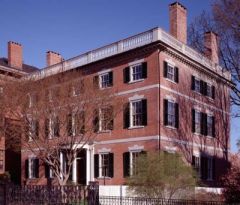
|
Samuel McIntire, Gardner-Pingree House, Salem, 1810
Further simplification of Pierce-Nichols House design in brick with horizontal belt courses Curving entrance portico Interior reveals Adam-style ornament Fan light much more decorative- leaded dividers Brick, limestone Composite columns Not symmetrical Rounded stair case- creates an oval element in the center of the house- sophisticated and roman Semi-circle extensions |
|
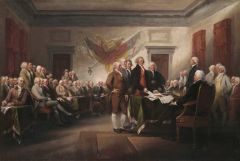
|
Trumbull, Declaration of Independence, 1786-1787
Recreation of key episode in American history w/help of John Adams & Jefferson inaccurate group portrait; lack of unifying action Preliminary study for later work in Capitol Attended Harvard Influenced by Copley Studied with West |
|

|
Joshua Johnston, Westwood Children 1807
Conversation piece Peale like heads with smallish bodies Simple interior with visible landscape Nothing neoclassical Doll like children Happy children Began life as a slave Influenced by Peale Extraordinary attention to the details |
|

|
John Haviland, Eastern State Penitentiary, Philly, 1821-1837, English born architect active in Philly, vaulted, castellated Gothic prison design, based on Samuel Benthams panopticon, radial plat- perfect square, fire proof, masonry design and vaulting
|

